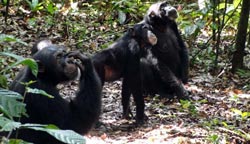Botanists in the rainforest

Chimpanzees gazing up tree crowns in their search for fruit. © Ammie Kalan <br>
Fruit-eating animals are known to use their spatial memory to relocate fruit, yet, it is unclear how they manage to find fruit in the first place.
Researchers of the Max Planck Institute for Evolutionary Anthropology in Leipzig, Germany, have now investigated which strategies chimpanzees in the Taï National Park in Côte d’Ivoire, West Africa, use in order to find fruit in the rain forest. The result: Chimpanzees know that trees of certain species produce fruit simultaneously and use this botanical knowledge during their daily search for fruit.
To investigate if chimpanzees know that if a tree is carrying fruit, then other trees of the same species are likely to carry fruit as well, the researchers conducted observations of their inspections, i.e. the visual checking of fruit availability in tree crowns. They focused their analyses on recordings in which they saw chimpanzees inspect empty trees, when they made “mistakes”.
By analysing these “mistakes”, the researchers were able to exclude that sensory cues of fruit had triggered the inspection and were the first to learn that chimpanzees had expectations of finding fruit days before feeding on it. They, in addition, significantly increased their expectations of finding fruit after tasting the first fruit in season. “They did not simply develop a ‘taste’ for specific fruit on which they had fed frequently”, says Karline Janmaat. “Instead, inspection probability was predicted by a particular botanical feature – the level of synchrony in fruit production of the species of encountered trees.”
The researchers conclude that chimpanzees know that trees of certain species produce fruit simultaneously and use this information during their daily search for fruit. They base their expectations of finding fruit on a combination of botanical knowledge founded on the success rates of fruit discovery and an ability to categorize fruits into distinct species. “Our results provide new insights into the variety of food-finding strategies employed by our close relatives, the chimpanzees, and may well elucidate the evolutionary origins of categorization abilities and abstract thinking in humans”, says Christophe Boesch, director of the Max Planck Institute for Evolutionary Anthropology’s Department of Primatology.
Contact
Karline R. L. Janmaat,
Max Planck Institute for Evolutionary Anthropology, Leipzig
Phone: +49 341 3550-227
Email: karline_janmaat@eva.mpg.de
Sandra Jacob,
Press and Public Relations
Max Planck Institute for Evolutionary Anthropology, Leipzig
Phone: +49 341 3550-122
Fax: +49 341 3550-119
Email: jacob@eva.mpg.de
Original publication
Karline R. L. Janmaat, Simone D. Ban & Christophe Boesch
Taï Chimpanzees use Botanical Skills to Discover Fruit: What we can Learn from their Mistakes
Animal Cognition, 10 April 2013
Media Contact
More Information:
http://www.mpg.de/7089161/chimpanzees-botanical-skillsAll latest news from the category: Life Sciences and Chemistry
Articles and reports from the Life Sciences and chemistry area deal with applied and basic research into modern biology, chemistry and human medicine.
Valuable information can be found on a range of life sciences fields including bacteriology, biochemistry, bionics, bioinformatics, biophysics, biotechnology, genetics, geobotany, human biology, marine biology, microbiology, molecular biology, cellular biology, zoology, bioinorganic chemistry, microchemistry and environmental chemistry.
Newest articles

A universal framework for spatial biology
SpatialData is a freely accessible tool to unify and integrate data from different omics technologies accounting for spatial information, which can provide holistic insights into health and disease. Biological processes…

How complex biological processes arise
A $20 million grant from the U.S. National Science Foundation (NSF) will support the establishment and operation of the National Synthesis Center for Emergence in the Molecular and Cellular Sciences (NCEMS) at…

Airborne single-photon lidar system achieves high-resolution 3D imaging
Compact, low-power system opens doors for photon-efficient drone and satellite-based environmental monitoring and mapping. Researchers have developed a compact and lightweight single-photon airborne lidar system that can acquire high-resolution 3D…





















